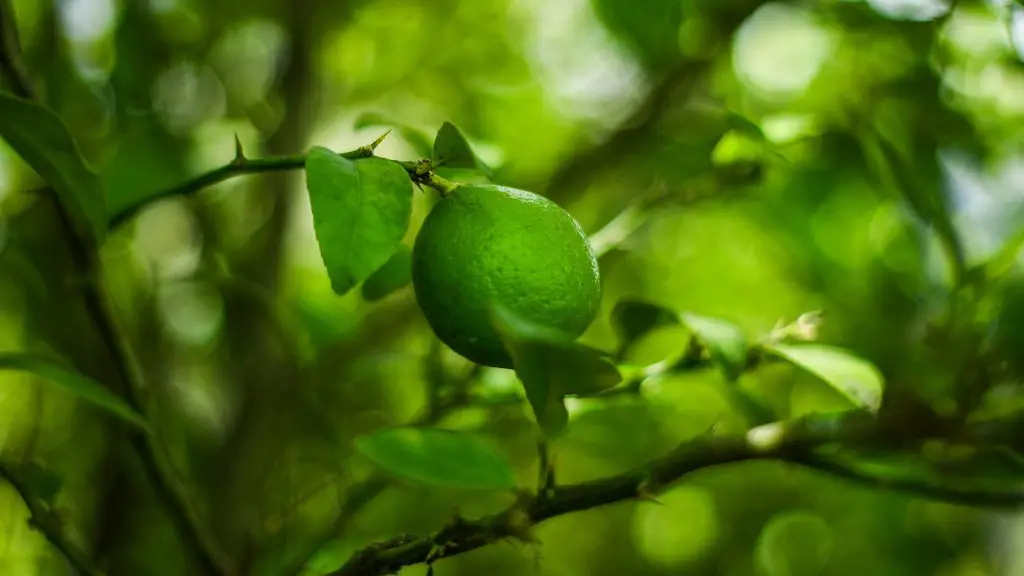How Tall Does An Avocado Tree Grow
Avocado trees (Persea americana) are tropical to subtropical evergreen trees popularly cultivated in home gardens and farms. A native of Central and South America, the avocado tree can live for decades and is known for its nutritional value and for producing a fruit consumed in many cuisines around the world. One common question among budding gardeners is how tall does an avocado tree grow?
The answer varies greatly depending on the variety, soil conditions, and the amount of available nutrients and water. Generally speaking, most varieties of avocado trees grow to 8 to 12 meters (26 to 40 feet) tall. However, some are known to reach 15 to 20 meters (50 to 65 feet) with greater set and care.
Some avocado varieties, such as Bacon and Hass, are self-fertile and will begin bearing fruit in as little as three to six years with minimal care. Others, like Fuerte and Sharwil, must be pollinated by other avocado varieties in order to produce a crop. Again, the height of the tree will depend largely on the variety, soil conditions and the amount of available nutrition and water.
According to the University of California-Riverside Extension Department, avocado trees thrive best in Mediterranean climates with long and warm periods of sunshine. They need ample water during the growing season, as well as well-draining soils and adequate levels of potassium and phosphorous. If avocado trees do not get enough sunlight, fertilizer and water, they tend to reach 9 to 10 meters (30 to 35 feet), but it is still possible for them to reach 15 meters (50 feet) and higher in the right conditions.
Another factor to consider when determining the mature height of an avocado tree is its branch structure. While some trees can maintain a central leader and form a single sturdy trunk, others will form multiple branches with many laterals. If a tree is allowed to grow without pruning, its natural branching pattern will determine its final height.
Size and Fruit Yield of the Tree
When avocado trees reach their full size, they can produce considerable amounts of fruit. A single mature tree can produce up to 200 fruits per year, although this may depend on the variety and the conditions of the climate. The size of the fruit will also vary depending on the variety, but most will range from 2.5 to 5 ounces and are round or pear-shaped, with a thick green leathery skin.
The amount of fruit produced by a single avocado tree will vary according to the age of the tree, the amount of sunshine and water it receives, and the overall fertility of the soil. With proper fertilization, pruning and care, an avocado tree has the potential to produce larger amounts of fruit. Additionally, avocado trees that are 3 to 6 years old tend to bear heavier crops than older trees.
Avocado trees are not only valuable for the fruit they produce, but also for the shade they offer. Avocado trees cast deep shade, making them an excellent choice for homeowners looking for a shady spot in their yard or garden.
Harvesting and Ripe Fruit
Avocado trees bear fruit from late winter to early summer, depending on the variety. However, the fruit is quite hard when it first appears and must be allowed to ripen in order to eat it. Some varieties of avocado may take up to 6 months to reach their peak ripeness. Therefore, fruit must be harvested early and stored properly to ripen adequately.
When harvesting an avocado, it is important to distinguish between ripe fruit and an over-ripe fruit. Fully ripe avocados will have a soft skin, whereas over-ripe avocados will have soggy or mushy skin. In addition, ripe avocados will be dark green to black in color and will have a faint aroma.
Avocado fruits ripen most evenly when they are stored at room temperature, away from direct sunlight. Once ripe, avocados can be stored in the refrigerator for up to 5 days, depending on the variety.
Health Benefits
Avocados are a rich source of essential vitamins, minerals, and healthy fats. They are particularly rich in Vitamin C, Vitamin E, potassium, and fiber, and the fatty acids found in avocados are known for their anti-inflammatory properties.
Research suggests that avocados may help to lower bad cholesterol (LDL) levels in the blood and promote healthier blood sugar levels. Additionally, avocados are a great source of heart-healthy monounsaturated and polyunsaturated fats, which can help reduce the risk of stroke and heart disease.
Avocados are also high in antioxidants, which can help to protect against oxidative damage. Avocados are especially high in carotenoids, which can protect against various diseases, including cancer, heart disease, and diabetes.
Avocados are not only a nutritious food, but they are also extremely versatile. They can be added to a variety of dishes and garnishes, such as salads, smoothies, and sandwiches. Avocado is also used in many beauty products, such as body lotion, shampoo, and facial masks.
Methods of Growing Avocados Trees
Avocado trees can be grown from seed in the ground or in containers. The method used will depend on the variety of avocado and the climate in which it will be grown. Avocado trees that are grown from seed can take many years to bear fruit, sometimes up to 10 years.
Alternatively, dormant plants, or grafted trees, can be purchased from nurseries and planted directly into the ground or into a pot. Grafts are created using a cutting from an existing tree and a compatible rootstock. Grafts require less time to bear fruit than trees grown from seed and can be a more cost-effective option.
In addition to planting grafted trees, there are also some types of avocados that do not require a rootstock. These types are usually referred to as seedlings, and they can be planted directly into the ground or into a pot. Seedlings require more care than grafted trees and tend to take longer to bear fruit, between three and five years.
Regardless of the method used for planting, it is important to ensure that the soil is well-drained and the area receives plenty of sunlight. Additionally, avocado trees need to be watered and fertilized regularly to achieve the full height and fruit-bearing potential.
Pests and Diseases
Avocado trees are also vulnerable to pests and diseases, such as root rot, powdery mildew, and scale insects. Growing avocado trees in containers will help protect them from many of these pests and diseases. This is because containers restrict the spread of pests and diseases and keep the soil consistently moist.
In addition, it is important to prune avocado trees regularly to remove dead or diseased branches. Pruning also helps promote healthy growth and encourages the production of more fruit. Mulching is also recommended for avocado trees, as it helps to keep the soil moist and protects the roots from extreme temperatures.
Conclusion
Avocado trees are a nutritionally valuable and versatile plant that, when grown in the right conditions, can be quite tall and produce plentiful, nutritious fruit. The height of an avocado tree will depend on the variety, soil conditions, and the amount of sunlight, water and nutrients available to it. Avocado trees can be grown from seed, grafted onto rootstock, or as seedlings, and require regular pruning, fertilizing, and protection from pests and diseases. With proper care, avocado trees can be an excellent addition to any garden or farm.




